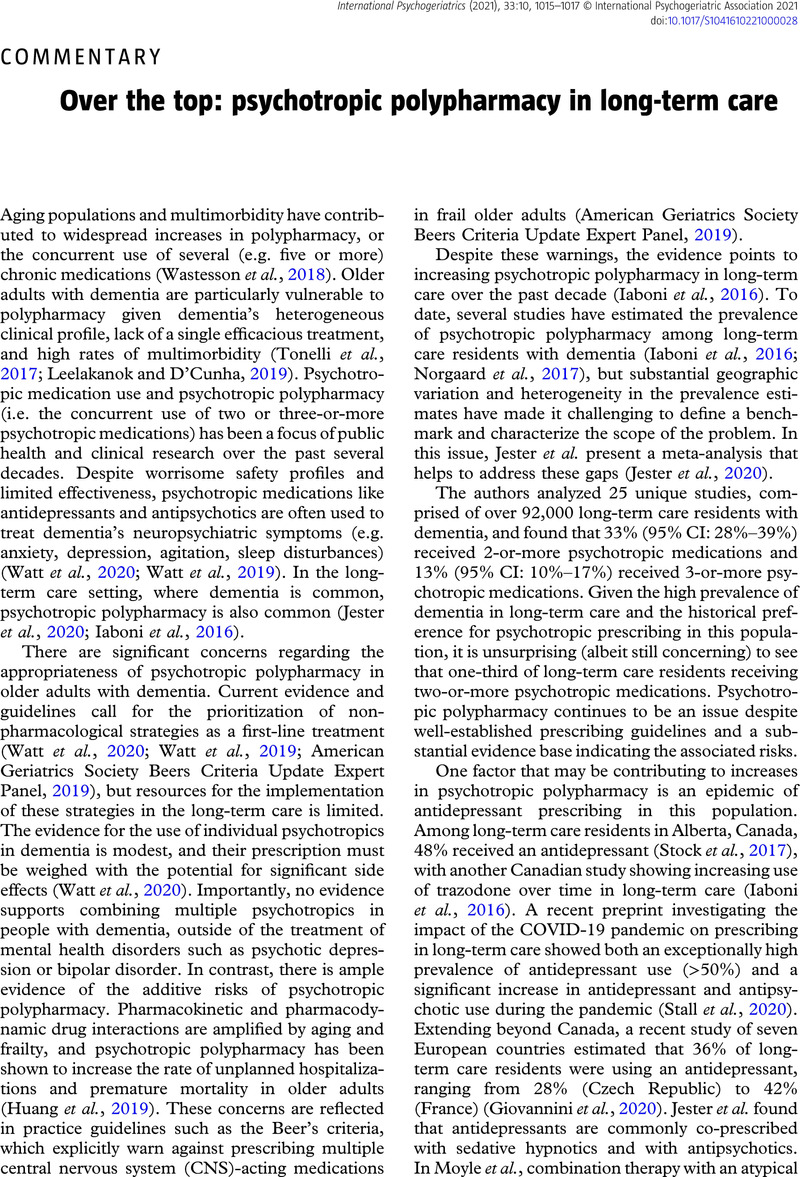No CrossRef data available.
Article contents
Over the top: psychotropic polypharmacy in long-term care
Published online by Cambridge University Press: 02 November 2021
Abstract
An abstract is not available for this content so a preview has been provided. Please use the Get access link above for information on how to access this content.

- Type
- Commentary
- Information
- International Psychogeriatrics , Volume 33 , Special Issue 10: Issue Theme: Non-cognitive Concerns in People with Dementia , October 2021 , pp. 1015 - 1017
- Copyright
- © International Psychogeriatric Association 2021
References
American Geriatrics Society Beers Criteria Update Expert Panel. (2019). American Geriatrics Society 2019 Updated AGS Beers Criteria(R) for Potentially Inappropriate Medication Use in Older Adults. Journal of the American Geriatrics Society 67, 674–694.Google Scholar
Giovannini, S. et al. (2020). Use of antidepressant medications among older adults in European long-term care facilities: a cross-sectional analysis from the SHELTER study. BMC Geriatrics, 20, 310.CrossRefGoogle ScholarPubMed
Harrison, S. L., Cations, M., Jessop, T., Hilmer, S. N., Sawan, M. and Brodaty, H. (2019). Approaches to Deprescribing Psychotropic Medications for Changed Behaviours in Long-Term Care Residents Living with Dementia. Drugs & Aging, 36, 125–136.CrossRefGoogle ScholarPubMed
Hilmer, S. N., Gnjidic, D. and Le Couteur, D. G. (2012). Thinking through the medication list - appropriate prescribing and deprescribing in robust and frail older patients. Australian Family Physician, 41, 924–928.Google ScholarPubMed
Huang, S. T., Wen, Y. W., Shur-Fen Gau, S., Chen, L. K. and Hsiao, F. Y. (2019). A Group-based Trajectory Analysis of Longitudinal Psychotropic Agent Use and Adverse Outcomes Among Older People. Journal of the American Medical Directors Association, 20, 1579–1586 e3.CrossRefGoogle ScholarPubMed
Iaboni, A., Bronskill, S. E., Reynolds, K. B., Wang, X., Rochon, P. A., Herrmann, N. and Alastair, J. F. (2016) Changing Pattern of Sedative Use in Older Adults: A Population-Based Cohort Study. Drugs & Aging, 33, 523–533.10.1007/s40266-016-0380-3CrossRefGoogle ScholarPubMed
Jester, D., Molinari, V., Zgibor, J. and Volicer, L. (2020) Prevalence of psychotropic polypharmacy in nursing home residents with dementia: a meta-analysis. International Psychogeriatrics, 33, 1083–1098.Google Scholar
Konetzka, R. T., Brauner, D. J., Shega, J. and Werner, R. M. (2014). The effects of public reporting on physical restraints and antipsychotic use in nursing home residents with severe cognitive impairment. Journal of the American Geriatrics Society, 62, 454–461.CrossRefGoogle ScholarPubMed
Kua, C. H., Mak, V. S. L. and Huey Lee, S. W. (2019). Health Outcomes of Deprescribing Interventions Among Older Residents in Nursing Homes: A Systematic Review and Meta-analysis. Journal of the American Medical Director Association, 20, 362–372 e11.CrossRefGoogle ScholarPubMed
Leelakanok, N. and D’cunha, R. R. (2019). Association between polypharmacy and dementia - A systematic review and metaanalysis. Aging and Mental Health, 23, 932–941.CrossRefGoogle ScholarPubMed
Maust, D. T., Kim, H. M., Chiang, C. and Kales, H. C. (2018). Association of the Centers for Medicare & Medicaid Services’ National Partnership to Improve Dementia Care With the Use of Antipsychotics and Other Psychotropics in Long-term Care in the United States From 2009 to 2014. JAMA Internal Medicine, 178, 640–647.CrossRefGoogle ScholarPubMed
Moyle, W. et al. (2017). Pharmacotherapy of Persons with Dementia in Long-Term Care in Australia: A Descriptive Audit of Central Nervous System Medications. Current Drug Safety.CrossRefGoogle ScholarPubMed
Norgaard, A., Jensen-Dahm, C., Gasse, C., Hansen, E. S. and Waldemar, G. (2017). Psychotropic Polypharmacy in Patients with Dementia: Prevalence and Predictors. Journal of Alzheimers Disease, 56, 707–716.10.3233/JAD-160828CrossRefGoogle ScholarPubMed
Piggott, K. L., Mehta, N., Wong, C. L. and Rochon, P. A. (2020). Using a clinical process map to identify prescribing cascades in your patient. BMJ, 368, m261.CrossRefGoogle ScholarPubMed
Stall, N. M. et al. (2020). Increased Prescribing of Psychotropic Medications to Ontario Nursing Home Residents during the COVID-19 Pandemic. medRxiv, 2020.11.26.20239525.Google Scholar
Stock, K. J., Amuah, J. E., Lapane, K. L., Hogan, D. B. and Maxwell, C. J. (2017). Prevalence of, and Resident and Facility Characteristics Associated With Antipsychotic Use in Assisted Living vs. Long-Term Care Facilities: A Cross-Sectional Analysis from Alberta, Canada. Drugs & Aging, 34, 39–53.CrossRefGoogle ScholarPubMed
Tonelli, M. et al. (2017). Multimorbidity, dementia and health care in older people:a population-based cohort study. CMAJ Open, 5, E623–E631.10.9778/cmajo.20170052CrossRefGoogle ScholarPubMed
Wastesson, J. W., Morin, L., Tan, E. C. K. and Johnell, K. (2018). An update on the clinical consequences of polypharmacy in older adults: a narrative review. Expert Opinion on Drug Safety, 17, 1185–1196.CrossRefGoogle ScholarPubMed
Watt, J. A. et al. (2020). Safety of pharmacologic interventions for neuropsychiatric symptoms in dementia: a systematic review and network meta-analysis. BMC Geriatrics, 20, 212.CrossRefGoogle ScholarPubMed
Watt, J. A. et al. (2019). Comparative Efficacy of Interventions for Aggressive and Agitated Behaviors in Dementia: A Systematic Review and Network Meta-analysis. Annals of Internal Medicine, 171, 633–642.CrossRefGoogle ScholarPubMed


